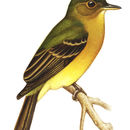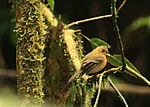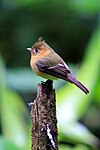zh-TW
在導航的名稱


Distribucion General: Se encuentran desde el noroeste de México hasta el noroeste de Ecuador y el este de Bolivia.
Los huevos son incubados exclusivamente por la hembra, la que durante esta tarea mueve su cabeza en forma constante para poder observar cualquier insecto que se acerque, atraparlo y retornar de nuevo al nido. En el período de anidación el macho lleva insectos a la hembra.
Mitrephanes phaeocercus, tamién conocíu como mosqueru copetón,[2] ye una especie d'ave paseriforme de la familia Tyrannidae.[1] Ye nativu del sur de Norteamerica, América Central y el norte de Suramérica. Reconócense ocho subespecies, incluyendo la subespecie nominal.[2]
La so área de distribución inclúi'l sur d'Estaos Xuníos, Méxicu, Guatemala, Hondures, Nicaragua, Costa Rica, Panamá, Colombia, y Ecuador.[1] El so hábitat compónse de monte subtropical y tropical, güelgues, y plantíos.[1]
Reconócense les siguientes subespecies:[2]
 Esta páxina forma parte del wikiproyeutu Aves, un esfuerciu collaborativu col fin d'ameyorar y organizar tolos conteníos rellacionaos con esti tema. Visita la páxina d'alderique del proyeutu pa collaborar y facer entrugues o suxerencies.
Esta páxina forma parte del wikiproyeutu Aves, un esfuerciu collaborativu col fin d'ameyorar y organizar tolos conteníos rellacionaos con esti tema. Visita la páxina d'alderique del proyeutu pa collaborar y facer entrugues o suxerencies. Mitrephanes phaeocercus, tamién conocíu como mosqueru copetón, ye una especie d'ave paseriforme de la familia Tyrannidae. Ye nativu del sur de Norteamerica, América Central y el norte de Suramérica. Reconócense ocho subespecies, incluyendo la subespecie nominal.
Aderyn a rhywogaeth o adar yw Gwybedog copog (sy'n enw gwrywaidd; enw lluosog: gwybedogion copog) a adnabyddir hefyd gyda'i enw gwyddonol Mitrephanes phaeocercus; yr enw Saesneg arno yw Tufted flycatcher. Mae'n perthyn i deulu'r Teyrn-wybedogion (Lladin: Tyrannidae) sydd yn urdd y Passeriformes.[1]
Talfyrir yr enw Lladin yn aml yn M. phaeocercus, sef enw'r rhywogaeth.[2]
Mae'r gwybedog copog yn perthyn i deulu'r Teyrn-wybedogion (Lladin: Tyrannidae). Dyma rai o aelodau eraill y teulu:
Rhestr Wicidata:
rhywogaeth enw tacson delwedd Elaenia’r Môr Tawel Myiopagis subplacens Gwybedog capanog Xenotriccus mexicanus Teyrn bach aelgoch Phylloscartes superciliaris Teyrn bach Ihering Phylloscartes difficilis Todi-deyrn Kempfer Hemitriccus kaempferi Todi-deyrn llydanbig Hemitriccus josephinae Todi-wybedog cyffredin Todirostrum cinereumAderyn a rhywogaeth o adar yw Gwybedog copog (sy'n enw gwrywaidd; enw lluosog: gwybedogion copog) a adnabyddir hefyd gyda'i enw gwyddonol Mitrephanes phaeocercus; yr enw Saesneg arno yw Tufted flycatcher. Mae'n perthyn i deulu'r Teyrn-wybedogion (Lladin: Tyrannidae) sydd yn urdd y Passeriformes.
Talfyrir yr enw Lladin yn aml yn M. phaeocercus, sef enw'r rhywogaeth.
The northern tufted flycatcher or simply tufted flycatcher (Mitrephanes phaeocercus) is a small passerine bird in the tyrant flycatcher family. It breeds in highlands from northwestern Mexico to northwestern Ecuador. The olive flycatcher (Mitrephanes olivaceus) of Peru and Bolivia is now considered a separate species.
It is a common inhabitant of mature mountain forest and tall second growth, especially at edges and clearings with trees. It breeds from 700–3000 m altitude, but is most abundant from 1200–2150 m. The female builds a saucer nest of moss, liverworts and lichens 4–27 m high on a branch or vine, usually concealed among ferns, bromeliads and other epiphytes. The female incubates the two brown-blotched white eggs for 15–16 days to hatching,
The northern tufted flycatcher is 12 cm long and weighs 8.5 g. The upperparts are olive-green, including the pointed crest. The tail and wings are blackish, and the latter have two buff wing bars and buff edging to the secondary feathers. The breast is ochre-orange, shading to bright yellow on the belly. Sexes are similar, but young birds have brownish upperparts with buff fringing, orange wing bars and paler underparts.
The northern tufted flycatcher is usually seen in pairs, hunting flying insects from an open perch like a pewee. It often returns to the same perch and vibrates its tail as it lands.
This species has a rapid weet weet weet weet call. Its dawn song is a very fast high bip-bip-bip-dididiup-bip-bip-bibibiseer.
Although this species is not migratory, it is very rare vagrant to the United States, the first record being from Big Bend National Park, Texas in November 1991. It has also been observed in Arizona.
The northern tufted flycatcher or simply tufted flycatcher (Mitrephanes phaeocercus) is a small passerine bird in the tyrant flycatcher family. It breeds in highlands from northwestern Mexico to northwestern Ecuador. The olive flycatcher (Mitrephanes olivaceus) of Peru and Bolivia is now considered a separate species.
It is a common inhabitant of mature mountain forest and tall second growth, especially at edges and clearings with trees. It breeds from 700–3000 m altitude, but is most abundant from 1200–2150 m. The female builds a saucer nest of moss, liverworts and lichens 4–27 m high on a branch or vine, usually concealed among ferns, bromeliads and other epiphytes. The female incubates the two brown-blotched white eggs for 15–16 days to hatching,
The northern tufted flycatcher is 12 cm long and weighs 8.5 g. The upperparts are olive-green, including the pointed crest. The tail and wings are blackish, and the latter have two buff wing bars and buff edging to the secondary feathers. The breast is ochre-orange, shading to bright yellow on the belly. Sexes are similar, but young birds have brownish upperparts with buff fringing, orange wing bars and paler underparts.
The northern tufted flycatcher is usually seen in pairs, hunting flying insects from an open perch like a pewee. It often returns to the same perch and vibrates its tail as it lands.
This species has a rapid weet weet weet weet call. Its dawn song is a very fast high bip-bip-bip-dididiup-bip-bip-bibibiseer.
Although this species is not migratory, it is very rare vagrant to the United States, the first record being from Big Bend National Park, Texas in November 1991. It has also been observed in Arizona.
Santa Elena Cloud Forest Reserve, Costa RicaEl mosquero moñudo común[3] (Mitrephanes phaeocercus), también conocido como mosquero copetón (en México), mosquero penachudo (en México), atrapamoscas moñudo (en Colombia), mosquerito moñudo (en Costa Rica), mosquero crestado (en Honduras) o mosquitero moñudo (en Nicaragua),[2] es una especie de ave paseriforme de la familia Tyrannidae una de las dos pertenecientes al género Mitrephanes.[1] Es nativo del sur de América del Norte, América Central y el norte de Sudamérica.
Su área de distribución incluye el sur de Estados Unidos (ocasionalmente en invierno en el oeste de Texas y oeste y sureste de Arizona),[4] México, Guatemala, Honduras, Nicaragua, Costa Rica, Panamá, Colombia, y Ecuador.[1]
Su hábitat se compone de bosque subtropical y tropical, humedales, y plantaciones.[1]
La especie M phaeocercus fue descrita por primera vez por el ornitólogo británico Philip Lutley Sclater en 1859 bajo el nombre científico Mitrephorus phaeocercus; localidad tipo «Córdoba, Veracruz, México.»[5]
Es pariente cercano de Mitrephanes olivaceus, y anteriormente fue considerado conespecífico.[5]
Existen divergencias entre las clasificaciones: mientras el Congreso Ornitológico Internacional (IOC) (Versión 5.3, 2015)[6] y otros reconocen 8 subespecies, Clements Checklist v.2015,[7] y otros reconocen solamente 4 subespecies, siendo que incluyen burleighi y nicaraguae en la nominal; vividus en aurantiiventris; y eminulus en berlepschi.[5] Con su correspondiente distribución geográfica:
El mosquero moñudo común (Mitrephanes phaeocercus), también conocido como mosquero copetón (en México), mosquero penachudo (en México), atrapamoscas moñudo (en Colombia), mosquerito moñudo (en Costa Rica), mosquero crestado (en Honduras) o mosquitero moñudo (en Nicaragua), es una especie de ave paseriforme de la familia Tyrannidae una de las dos pertenecientes al género Mitrephanes. Es nativo del sur de América del Norte, América Central y el norte de Sudamérica.
Mitrephanes phaeocercus Mitrephanes generoko animalia da. Hegaztien barruko Tyrannidae familian sailkatua dago.
Mitrephanes phaeocercus Mitrephanes generoko animalia da. Hegaztien barruko Tyrannidae familian sailkatua dago.
Töyhtösieppari (Mitrephanes phaeocercus) on Keski- ja Etelä-Amerikassa tavattava tyranneihin kuuluva varpuslintu.
Kooltaan töyhtösieppari on noin 13 cm. Selästään laji on väriltään oliivinvihreä. Linnun naama on vaalean oranssin rusehtava ja päälaen töyhtö on ruskea. Linnun silmien ympärillä on vaalea rengas. Töyhtösiepparin siivet ovat mustat ja niissä on valkoisia juovia, jotka ovat nuorilla linnuilla aikuisia selvemmät. Kurkku ja rinta ovat lajilla oranssinrusehtavat ja vatsa on väritykseltään keltainen.[3][4]
Töyhtösiepparia tavataan Keski-Amerikassa Meksikosta etelään Panamaan asti. Etelä-Amerikassa lajin levinneisyysalueeseen kuuluvat Kolumbian länsiosat ja Kaakkois-Ecuador. Laji on harhautunut myös Yhdysvaltoihin ja se on tavattu kaksi kaksi kertaa sekä Arizonan että Texasin osavaltioiden alueelta. Linnun elinympäristöä ovat kosteat ja puolikosteat mäntyä ja tammea kasvavat sekametsät, kosteat lehtimetsät sekä viljelmät. Talvisin laji elää puoliavoimilla mailla. Töyhtösiepparin elinympäristöt sijaitsevat yleensä 100–600 metrin korkeudella merenpinnasta.[3][4][5]
Töyhtösiepparit liikkuvat yleensä yksin tai pareittain. Lajin ravinto koostuu hyönteisistä, joita se pyydystää ilmasta. Linnun kuppimainen pesä rakennetaan ruohoista, juurista ja sammaleesta oksanhaarukkaan. Naarastöyhtösieppari munii kaksi valkeahkoa ruskeapilkullista munaa.[3][4]
Töyhtösieppari (Mitrephanes phaeocercus) on Keski- ja Etelä-Amerikassa tavattava tyranneihin kuuluva varpuslintu.
Mitrephanes phaeocercus
Le Moucherolle huppé (Mitrephanes phaeocercus) est une espèce de passereau placée dans la famille des Tyrannidae. Ce taxon est considéré comme conspécifique avec le Moucherolle olive (Mitrephanes olivaceus) par certains auteurs[1].
Cet oiseau a été décrit en 1859 par Philip Lutley Sclater sous le nom scientifique de Mitrephorus phaeocercus[1].
On compte, selon les classifications, 4 ou 8 sous-espèces de Mitrephanes phaeocercus. Il existe en effet des divergences concernant leur classification : le Congrès ornithologique international inclut Mitrephanes phaeocercus burleighi et Mitrephanes phaeocercus nicaraguae avec la sous-espèce de référence Mitrephanes phaeocercus phaeocercus, vividus avec aurantiiventris et eminulus avec berlepschi. Par contre, le Système d'information taxonomique intégré (ITIS) les sépare toutes[2],[3].
Mitrephanes phaeocercus
Le Moucherolle huppé (Mitrephanes phaeocercus) est une espèce de passereau placée dans la famille des Tyrannidae. Ce taxon est considéré comme conspécifique avec le Moucherolle olive (Mitrephanes olivaceus) par certains auteurs.
De geelbuiktiran (Mitrephanes phaeocercus) is een zangvogel uit de familie Tyrannidae (tirannen).
Deze soort telt 8 ondersoorten:
De geelbuiktiran (Mitrephanes phaeocercus) is een zangvogel uit de familie Tyrannidae (tirannen).
Tofstyrann[2] (Mitrephanes phaeocercus) är en fågel i familjen tyranner inom ordningen tättingar.[3] IUCN kategoriserar arten som livskraftig.[1]
Tofstyrann delas in i fyra underarter:[3]
Tofstyrann (Mitrephanes phaeocercus) är en fågel i familjen tyranner inom ordningen tättingar. IUCN kategoriserar arten som livskraftig.
Tofstyrann delas in i fyra underarter:
phaeocercus/tenuirostris-gruppen Mitrephanes phaeocercus tenuirostris – förekommer i bergsområden i västra Mexiko (Sonora och Chihuahua till Jalisco) Mitrephanes phaeocercus phaeocercus – förekommer i bergsområden från östra Mexiko till El Salvador och nordöstra Nicaragua Mitrephanes phaeocercus aurantiiventris – förekommer i högländer i Costa Rica och västra Panama Mitrephanes phaeocercus berlepschi – förekommer från östligaste Panama och nordvästra Colombia till nordvästra Ecuador


Mitrephanes phaeocercus là một loài chim trong họ Tyrannidae.[1]
Mitrephanes phaeocercus là một loài chim trong họ Tyrannidae.